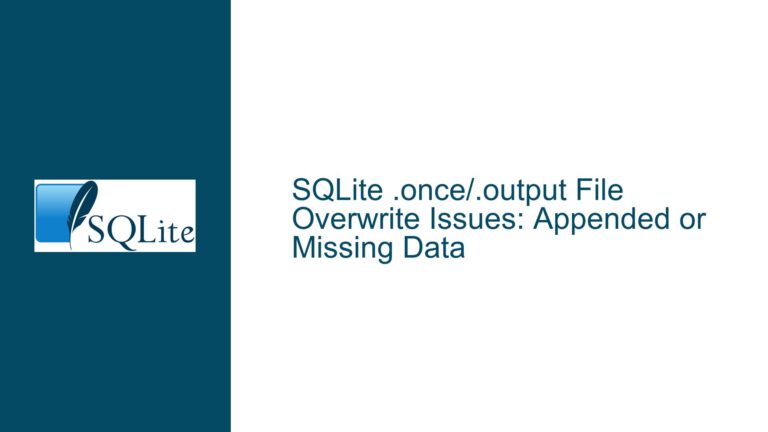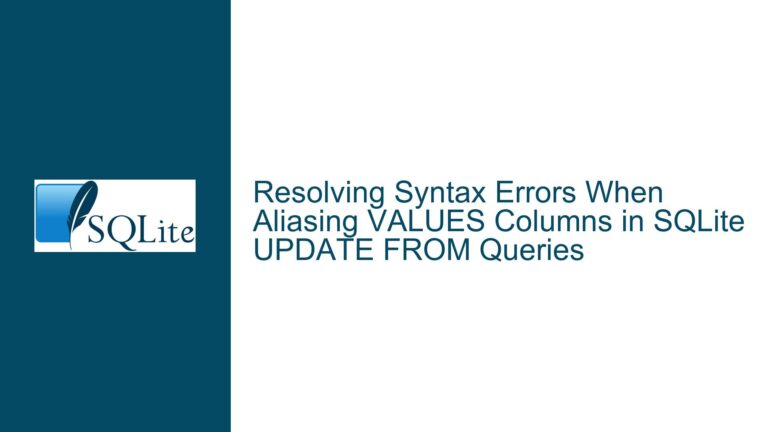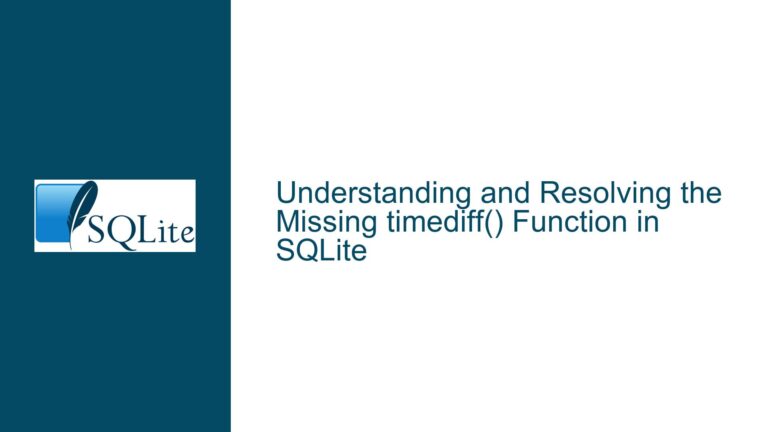Filtering and Exporting SQLite Data to CSV with Complex Conditions
Understanding the Requirements for Filtering and Exporting Data
The core issue revolves around filtering specific columns (id, type, name, images) from a table (mediaitems) in an SQLite database (library.db) and exporting the results to a CSV file. The filtering conditions are based on the values in the type and images columns. Specifically, the type column must equal 6, and the images column must meet one of the following conditions: it should either be NULL, contain no http substring, or not contain the | character or the MetadataPath substring. The goal is to generate separate CSV files for each of these conditions.
This task involves understanding SQLite’s querying capabilities, its command-line interface (sqlite3.exe), and the nuances of filtering data based on complex string conditions. Additionally, the user is working on a Windows environment, which may introduce specific considerations for file paths and command execution.
Identifying the Challenges in Filtering and Exporting Data
The primary challenges in this scenario include:
Complex Filtering Conditions: The
imagescolumn contains strings with varying formats, includingNULLvalues, local file paths, and URLs. The filtering logic must account for these variations, which requires a deep understanding of SQLite’s string manipulation functions and pattern matching capabilities.Multiple Output Files: The user wants to generate separate CSV files for each filtering condition. This requires running multiple queries and ensuring that each query’s output is directed to a distinct file.
Command-Line Execution: The user prefers using the
sqlite3.execommand-line tool on Windows. This necessitates familiarity with SQLite’s command-line interface, including its dot-commands (e.g.,.mode,.output,.quit) and how they interact with the operating system.Data Integrity and Accuracy: Ensuring that the exported data accurately reflects the filtering conditions is crucial. Misapplied filters or incorrect query logic could lead to incomplete or erroneous CSV files.
Performance Considerations: Depending on the size of the
mediaitemstable, the queries may need to be optimized to avoid excessive execution times or resource consumption.
Step-by-Step Troubleshooting and Solutions for Filtering and Exporting Data
Step 1: Setting Up the SQLite Environment
Before executing any queries, ensure that the SQLite command-line tool (sqlite3.exe) is correctly installed and accessible from the command prompt. Verify the installation by running sqlite3 --version in the command prompt. If the tool is not recognized, add its directory to the system’s PATH environment variable.
Step 2: Connecting to the Database
Open the command prompt and navigate to the directory containing the library.db file. Start the SQLite command-line interface by running sqlite3 library.db. This command opens the database and prepares it for querying.
Step 3: Configuring the Output Format
To export query results to a CSV file, configure the output mode using the .mode dot-command. Set the mode to csv by executing .mode csv. This ensures that the results are formatted as comma-separated values.
Step 4: Filtering Data Based on NULL or Empty images
The first filtering condition requires selecting rows where the type column equals 6 and the images column is either NULL or an empty string. The SQL query for this condition is:
SELECT id, type, name, images
FROM mediaitems
WHERE type = 6
AND (images IS NULL OR images = '');
To export the results to a CSV file, use the .output dot-command to specify the output file:
.output null_or_empty_images.csv
Execute the query, and then close the output file by running .output stdout. This ensures that subsequent queries do not overwrite the same file.
Step 5: Filtering Data Based on the Absence of http in images
The second filtering condition requires selecting rows where the type column equals 6 and the images column does not contain the http substring. The SQL query for this condition is:
SELECT id, type, name, images
FROM mediaitems
WHERE type = 6
AND images NOT LIKE '%http%';
Set the output file for this query:
.output no_http_images.csv
Execute the query, and then reset the output to the standard output:
.output stdout
Step 6: Filtering Data Based on the Absence of | and MetadataPath in images
The third filtering condition requires selecting rows where the type column equals 6 and the images column does not contain the | character or the MetadataPath substring. The SQL query for this condition is:
SELECT id, type, name, images
FROM mediaitems
WHERE type = 6
AND images NOT LIKE '%|%'
AND images NOT LIKE '%MetadataPath%';
Set the output file for this query:
.output no_pipe_or_metadatapath_images.csv
Execute the query, and then reset the output to the standard output:
.output stdout
Step 7: Verifying the Exported CSV Files
After executing all queries, verify the contents of the exported CSV files (null_or_empty_images.csv, no_http_images.csv, no_pipe_or_metadatapath_images.csv) to ensure they contain the correct data. Open each file in a text editor or spreadsheet application and confirm that the rows meet the respective filtering conditions.
Step 8: Optimizing Query Performance (Optional)
If the mediaitems table is large, consider optimizing the queries by adding indexes on the type and images columns. For example, create an index on the type column:
CREATE INDEX idx_type ON mediaitems(type);
This index can significantly speed up the filtering process, especially if the table contains millions of rows.
Step 9: Automating the Process with a Script (Optional)
To streamline the process, create a batch script (export_data.bat) that automates the execution of the SQLite commands. The script should include the following commands:
@echo off
sqlite3 library.db <<EOF
.mode csv
.output null_or_empty_images.csv
SELECT id, type, name, images FROM mediaitems WHERE type = 6 AND (images IS NULL OR images = '');
.output stdout
.output no_http_images.csv
SELECT id, type, name, images FROM mediaitems WHERE type = 6 AND images NOT LIKE '%http%';
.output stdout
.output no_pipe_or_metadatapath_images.csv
SELECT id, type, name, images FROM mediaitems WHERE type = 6 AND images NOT LIKE '%|%' AND images NOT LIKE '%MetadataPath%';
.output stdout
.quit
EOF
Run the script by executing export_data.bat in the command prompt. This approach ensures consistency and reduces the risk of manual errors.
Step 10: Handling Edge Cases and Errors
During the execution of the queries, be mindful of potential edge cases and errors. For example, if the images column contains unexpected data formats, the queries may not return the desired results. In such cases, review the data and adjust the filtering conditions accordingly. Additionally, ensure that the output files are not overwritten unintentionally by resetting the output to stdout after each query.
Step 11: Exploring Advanced Filtering Techniques
For more complex filtering scenarios, consider using SQLite’s advanced string functions, such as INSTR, SUBSTR, and REPLACE. These functions can help refine the filtering logic and handle more intricate data patterns. For example, to filter rows where the images column contains a specific substring at a particular position, use the INSTR function:
SELECT id, type, name, images
FROM mediaitems
WHERE type = 6
AND INSTR(images, 'specific_substring') > 0;
This query selects rows where the images column contains the substring specific_substring.
Step 12: Ensuring Data Consistency and Integrity
After exporting the data, perform a final check to ensure data consistency and integrity. Compare the number of rows in each CSV file with the expected results based on the filtering conditions. If discrepancies are found, revisit the queries and adjust the filtering logic as needed.
Step 13: Documenting the Process
Document the entire process, including the SQL queries, command-line instructions, and any scripts used. This documentation serves as a reference for future tasks and helps others understand the steps involved in filtering and exporting data from SQLite databases.
Step 14: Exploring Alternative Tools and Methods
While the sqlite3.exe command-line tool is effective, consider exploring alternative tools and methods for filtering and exporting data. For example, using a graphical database management tool like DB Browser for SQLite can simplify the process, especially for users who are less comfortable with command-line interfaces. Additionally, programming languages like Python offer libraries (e.g., sqlite3, pandas) that can automate and enhance the data export process.
Step 15: Continuous Learning and Improvement
Finally, embrace a mindset of continuous learning and improvement. As you gain more experience with SQLite and database management, explore advanced topics such as database normalization, query optimization, and data migration. This knowledge will empower you to tackle more complex challenges and deliver robust solutions.
By following these detailed troubleshooting steps and solutions, you can effectively filter and export data from an SQLite database to CSV files, even when dealing with complex filtering conditions. This approach ensures data accuracy, optimizes performance, and provides a solid foundation for future database tasks.






